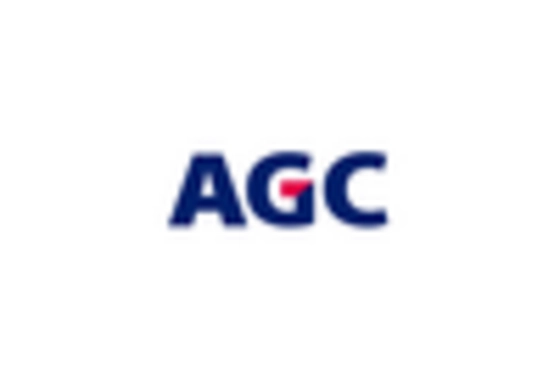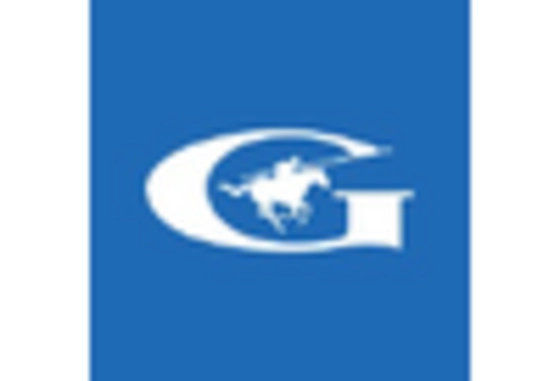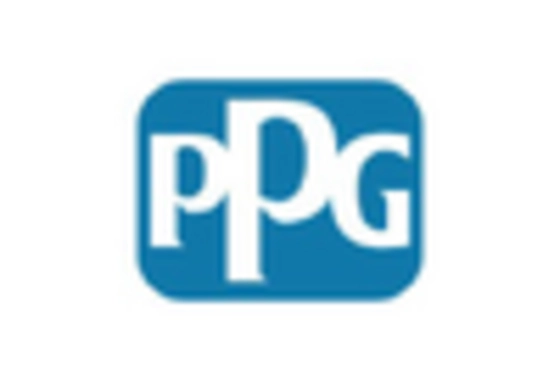Increased Safety Standards
The Automotive Encapsulated Glass Market is significantly influenced by the rising safety standards imposed by regulatory bodies. Encapsulated glass offers enhanced safety features, such as improved shatter resistance and better structural integrity, which are increasingly demanded by consumers and mandated by regulations. As automakers prioritize passenger safety, the integration of advanced glass technologies becomes essential. The market is likely to see a surge in encapsulated glass applications in windshields and side windows, as these components are critical for vehicle safety. Furthermore, the global push for higher safety ratings is expected to drive the adoption of encapsulated glass, thereby fostering growth in the Automotive Encapsulated Glass Market.
Growing Electric Vehicle Adoption
The Automotive Encapsulated Glass Market is poised for growth due to the increasing adoption of electric vehicles (EVs). As the automotive landscape shifts towards electrification, manufacturers are seeking lightweight and energy-efficient components to enhance the performance of EVs. Encapsulated glass, with its lightweight properties, aligns well with the requirements of electric vehicles, contributing to improved range and efficiency. Market analysts project that the demand for encapsulated glass in EVs will rise significantly, as automakers aim to optimize vehicle design and performance. This trend not only supports the growth of the Automotive Encapsulated Glass Market but also reflects the broader transition towards sustainable transportation solutions.
Rising Demand for Lightweight Materials
The Automotive Encapsulated Glass Market is experiencing a notable shift towards lightweight materials, driven by the automotive sector's focus on enhancing fuel efficiency and reducing emissions. Encapsulated glass, being lighter than traditional glass, contributes to weight reduction in vehicles, which is crucial for meeting stringent environmental regulations. As manufacturers strive to comply with these regulations, the demand for lightweight solutions is expected to rise. Reports indicate that the encapsulated glass segment is projected to grow at a compound annual growth rate of approximately 6% over the next few years. This trend not only supports sustainability goals but also aligns with consumer preferences for more efficient vehicles, thereby propelling the Automotive Encapsulated Glass Market forward.
Consumer Preference for Aesthetic Appeal
The Automotive Encapsulated Glass Market is increasingly influenced by consumer preferences for aesthetic appeal and design innovation. Modern consumers are drawn to vehicles that not only perform well but also exhibit stylish and contemporary designs. Encapsulated glass allows for greater design flexibility, enabling manufacturers to create sleek and visually appealing vehicle exteriors. This trend is particularly evident in luxury and high-end vehicles, where the integration of encapsulated glass enhances the overall aesthetic. As automakers respond to these consumer demands, the Automotive Encapsulated Glass Market is likely to experience growth, driven by the need for innovative and attractive glass solutions that complement modern vehicle designs.
Technological Innovations in Glass Manufacturing
Technological advancements in glass manufacturing processes are playing a pivotal role in shaping the Automotive Encapsulated Glass Market. Innovations such as improved lamination techniques and the development of smart glass technologies are enhancing the functionality and appeal of encapsulated glass. These advancements not only improve the aesthetic qualities of vehicles but also introduce features like electrochromic glass, which can adjust transparency based on light conditions. As manufacturers adopt these cutting-edge technologies, the market is likely to witness an increase in the variety and performance of encapsulated glass products. This trend suggests a promising future for the Automotive Encapsulated Glass Market, as consumers increasingly seek vehicles equipped with advanced glass solutions.


















Leave a Comment